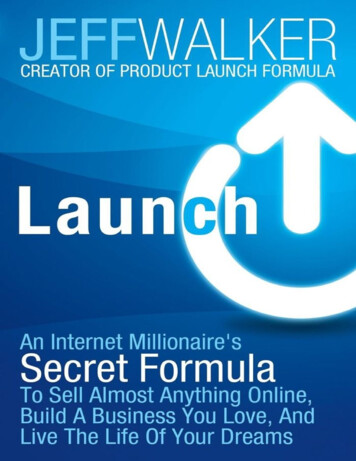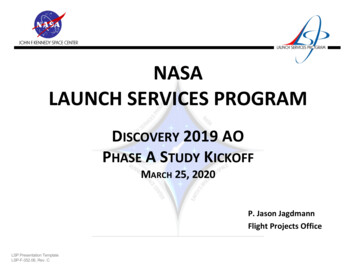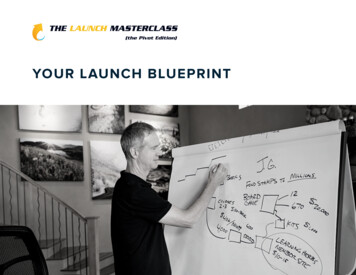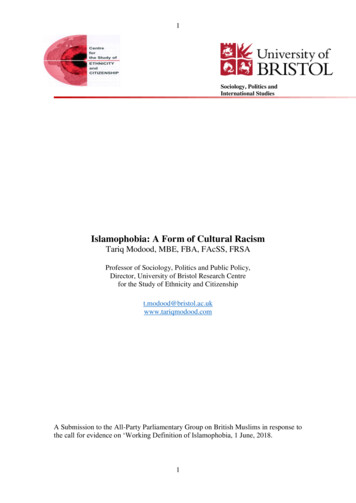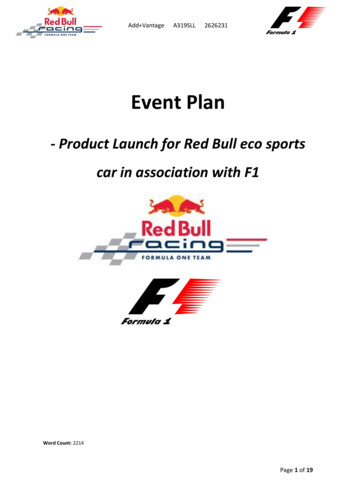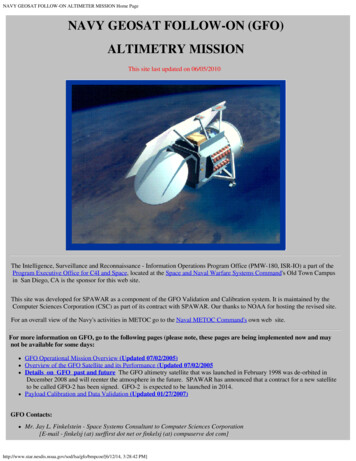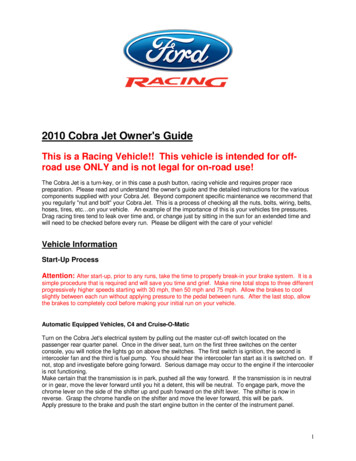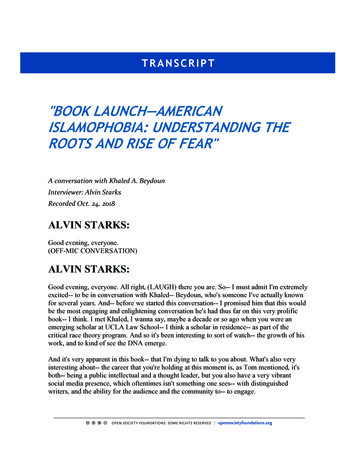
Transcription
TRANSCRIPT"BOOK LAUNCH—AMERICANISLAMOPHOBIA: UNDERSTANDING THEROOTS AND RISE OF FEAR"A conversation with Khaled A. BeydounInterviewer: Alvin StarksRecorded Oct. 24, 2018ALVIN STARKS:Good evening, everyone.(OFF-MIC CONVERSATION)ALVIN STARKS:Good evening, everyone. All right, (LAUGH) there you are. So-- I must admit I'm extremelyexcited-- to be in conversation with Khaled-- Beydoun, who's someone I've actually knownfor several years. And-- before we started this conversation-- I promised him that this wouldbe the most engaging and enlightening conversation he's had thus far on this very prolificbook-- I think. I met Khaled, I wanna say, maybe a decade or so ago when you were anemerging scholar at UCLA Law School-- I think a scholar in residence-- as part of thecritical race theory program. And so it's been interesting to sort of watch-- the growth of hiswork, and to kind of see the DNA emerge.And it's very apparent in this book-- that I'm dying to talk to you about. What's also veryinteresting about-- the career that you're holding at this moment is, as Tom mentioned, it'sboth-- being a public intellectual and a thought leader, but you also have a very vibrantsocial media presence, which oftentimes isn't something one sees-- with distinguishedwriters, and the ability for the audience and the community to-- to engage.
TRANSCRIPT: B OOK LAUNCH —AMERICAN ISLAMOPHOB IA: UNDERSTANDING THE ROOTS AND RISE OF FEARThis conversation probably couldn't be more timely than ever before. And so I wanna sortajust jump right in. Because-- as we think about, you know, both this book and its content, itlives in a space both of-- where race, Muslim identity, democracy, and current affairs sortamerge. And so my first question's a very simple one and a very basic one. Where do we findthis book? Where is it listed in the bookstore, under what section? Because the-- the breadthof it is so, dare I say, intersectional-- on purpose, and so it's hard to kind of say it is thatbook or this book. So I wanna start there. What-- what are you trying to do with AmericanIslamophobia?KHALED A. BEYDOUN:So first of all, thank you so much to Open Society Foundation for hosting and giving me anopportunity to speak to you about-- this book, and salaam alaikum. Hope you guys are alldoin'-- well this evening. So-- where can you find this book? I think that really is-- hinges onwhich bookstore you walk into.The fact that you find it in different places in different bookstores I think is a testament to-the-- the intersectional work, the kind of broad-based work I seek to do with this book. Insome bookstores it's in the-- the American history section, and a heavy component of thebook examines American-- legal-- racial and immigration history.Some books have it in the-- race and ethnicity section, because as a critical race theorist-the importance of race and racism to my analysis-- of Islamophobia is extremely importantand salient. Some people have it in, ironically enough (and this is problematic) in the Islamicstudies or the religion section, because there's a routine sort of-- dare I say, orientalistconflation of anything dealing with Muslim identity as being religious-- and specificallyIslamic.So it's probably harder to find in that section. I-- I-- I l-- if I can segue a bit, last night I did atalk at 92 and Y, and the vast majority of the questions I was getting were-- wereaddressing-- Islamic law. So having me kind of probe sharia law questions, which again, youknow, go to the idea that-- just because you're addressing Muslim identity or Islam does notmean you're concerned (NOISE) with examining-- theological questions. But you can find itin a range of places-- which I think can be good, but citing the latter example, can be a badthing as well.ALVIN STARKS:But-- Khaled, in all honesty, I'm-- I wanna go-- to another direction. I'm curious to knowwhy this book, right? Like-- the-- the question of Islamophobia-- as you brilliantly illustrate,has actually been with us-- for, dare I say, centuries. But it's actually now moved to a newterrain, right? The kind of watching it be politicized and publicized-- in a way that weprobably haven't seen in at least the last 30 or 40 years. So why produce something thatalready exist, but it felt like you were tryin' to do a bit of a refresh?2
TRANSCRIPT: B OOK LAUNCH —AMERICAN ISLAMOPHOB IA: UNDERSTANDING THE ROOTS AND RISE OF FEARKHALED A. BEYDOUN:Yeah. So two reasons. I think there was-- there was an immediate kind of political-- concernto write this book at this time because of the-- the uptick, the intensification of Islamophobiathat was ushered in by-- by-- by Trump, now President Trump, when he was a candidatevying for the Republican nomination. It was obviously a very pressing issue that-- youknow, media pundits, scholars, activists, advocates were all rushing toward-- in-- in-- in-- ina very urgent fashion.So that political obj-- you know, aspiration to kind of, you know-- address what washappening in real-time in the country-- in a very trenchant way wa-- was of critical concernto me. The second-- objective, which-- I think was more potent in inspiring me to write thisbook-- was the idea that there was, I think, a lot of flattening of what Islamophobia meant interms of the way it was being discussed-- in discursive spaces, bl-- specifically the media-but also among scholars. I-- you know, th-- it was refreshing for me-- as somebodyexamining this topic, and also as a critical race theorist, to see that the term Islamophobiahad been championed by a broad-- cross-section of people. But it was-- it-- it was not beingdefined in a way that was doing justice to what-- what I was-- what was actually happening.So for instance, when activists were saying, "Islamophobia," or somebody like AndersonCooper were say-- was saying, "Islamophobia," they were specifically focused in-- withwhat these private actors were doing, right? So like hatemongers, bigots-- that are viewed tobe deviant or aberrational, right?Individuals that were not-- acting on behalf-- of what the state was doing, and second, werenot acting on behalf of what broader society-- was sort of encouraging with regard to animusto Muslims. And I wanted to-- to kind of broaden it to-- to kind of examine the idea that youcan't talk about Islamophobia unless we talk about the War on Terror, and the various-apparatuses and laws that the state has been enacting since-- the aftermath of 9/11-- the 9/11terror attacks.And second, there was this kind of-- broad sort of leviathan kind of hovering in theatmosphere called orientalism, that no one was connecting modern Islamophobia to thislongstanding tradition-- and epistemology of orientalism that actually existed in theAmerican imagination before this country was a sovereign nation.So it was doing all those things, first the political sort of-- immediate political-- objective,and second, the broader intellectual piece-- that drives from my academic scholarship that Iwanted to deconstruct in a way that c-- that could be accessible to a broader audience.ALVIN STARKS:Uh-huh (AFFIRM). And-- and that intellectual piece, right-- so this goes back to actuallyhow I first met you-- from critical race theory, right, pioneered oftentimes-- coined byDerrick Bell and many others. But usually in the critical race space you didn't see a focus onIslam or even Muslim populations. So-- at-- at some level, you know, you're actually3
TRANSCRIPT: B OOK LAUNCH —AMERICAN ISLAMOPHOB IA: UNDERSTANDING THE ROOTS AND RISE OF FEARengineering something that feels relatively new. And so I'm just curious, like, so how doesone come to this space of merging-- and we should also define what critical race theory is-merging critical race theory and Islam?KHALED A. BEYDOUN:Great question. So-- (LAUGH) it's a hard one-- to respond to, 'cause it forces me to go backin my own kinda, like, personal history. But I'll do some-- autobiographicalcontextualization that might give you guys some idea as to why I decided to become anacademic, and specifically a critical race theorist.So the 9/11 terror attacks happened two weeks after I was a law student in law school. Ispecifically chose to go to the UCLA School of Law because it's a school that boasts theonly-- concentration in critical race theory. So UCLA hosts luminaries like Cheryl Harris,who wrote Whiteness as Property, people like Devon Carbado, who's done really importantwork on the fourth amendment-- and identity performance theory, and Kimberle Crenshaw,my mentor and-- a good friend of Alvin's who coined this term, intersectionality.Her work has obviously been very foundational to the advancement of critical race theoryas-- a intellectual discipline. So I was in law school at this time, examining critical racetheory in a range of questions that were grappling with the experience of AfricanAmericans, Latinx-- populations, Native Americans, the struggle of-- LGBTQ communities,the importance of-- gender in how it-- interacts with the law.And I was finding that there was a dearth, if not-- a complete nonexistence of literatureexamining what was was happening-- with Muslim-Americans in real-time. So at that point,I'll be frank with you guys, I didn't think that it was possible for me to be-- a law scholarbecause I wasn't somebody who comes from a conventional kind of-- circumstance where Ithought that was possible, right?I had f-- I'm somebody who flunked freshman year of high school, I transferred to universityfrom-- a city college. I was a better boxer than I was a writer (LAUGH) growin' up-- as ayoung man. But it-- it was s-- it was inspirational for me to see scholars of color, likeProfessor Crenshaw and Professor Harris, examine the law in a very incisive way from aracial standpoint.And that sort of moved me-- to wanna v-- to wanna make that contribution. So-- back towhat you said, Alvin, I was very much I think, maybe one of the first, if not the first,Muslim-American critical race theorists-- that, you know, really tried to merge the canon ofcritical race theory with what was happening with Muslim-Americans-- and how Islam wasalso being demonized as a religion-- in real-time during the War on Terror, but also-- wellbefore the War on Terror moment. I told Alvin he can cut me off 'cause, you know, lawprofessors, we have a penchant for being long-winded. I ta-- (LAUGH)4
TRANSCRIPT: B OOK LAUNCH —AMERICAN ISLAMOPHOB IA: UNDERSTANDING THE ROOTS AND RISE OF FEARALVIN STARKS:No, no, no. You-- you-- you're perfect. Don't-- don't-- do not worry. But I wanna pick upsomething else that the book does that I think is incredibly eloquent and important. Youreally provide a very rich historical literacy, right? So there are moments when we believethat the experiences that we're having in the real-time do not, or feel-- they're new to us, butthey have historical relevance.And there is a piece in the book that I wanted to read because I think it kind of does a greatjob of kinda giving us a snapshot, right? And-- the woman here, her name is Nora, and I justwanna kind of read a few-- sentences that I thought was just breathtaking. This is Nora'svoice: "'I don't know what to do,' she revealed to a circle of family and friends. BeingMuslim in America has always been wrought with scrutiny and suspicion. But the entranceof Trump spelled emboldened Islamophobia, and for conspicuous Muslims like Nora, a farhigher likelihood of harm."Quote-unquote, "'Acting Muslim', today in the United States invites suspicion from the stateand maximizes the prospect of backlash from hatemongers. For Muslim-Americans whoconfirm their religious identity by wearing head-- s-- headscarves or Islamic dress, fastingon Ramadan, and regularly attending the mosque, merely practicing their first amendmentrights is perilous. Muslim-Americans like Nora, driven by fear to conform, cover, or concealtheir Muslim identity may diminish the prospect of suspicion from the state or backlashfrom bigots, but in doing so they are complacent in supporting the very missionIslamophobia aims to advance: eroding and eliminating every manifestation of Islam until itis gone from America altogether."When I read that part-- I mean, it's breath s-- breathtaking for a whole host of reasons. Butthis-- public conversation and desire for erasure. I wanna hear more about when you weredoing the research for this, how prevalent was this notion of erasure and this idea or thiscontention (if it exists)-- between, "Can I be free to worship and dress as I like, and also besafe and American simultaneously?"KHALED A. BEYDOUN:Well, you know, for me when I was-- when I was writing the book-- and Nora is-- a youngwoman I've known from the Detroit community for-- for some time. She-- was a familyfriend-- who, you know, evolved into a community activist, somebody who was extremelyreligiously pious and really struggled with-- you know, expressing her Muslim identitypublicly after the-- the ascendance-- of Trump. So I had moved back to Detroit where I'mfrom-- during the-- the campaign moment. And many of you guys might know, Detroit ishome to one of the most concentrated and actually diverse Muslim communities in thecountry-- along racial, ethnic, and even sectarian lines-- and also socioeconomic lines.Detroit is home to-- a very sizable poor and working class-- Muslim community. But-when-- when I was writing that and when I was engaging with Nora I was thinking about the5
TRANSCRIPT: B OOK LAUNCH —AMERICAN ISLAMOPHOB IA: UNDERSTANDING THE ROOTS AND RISE OF FEARconcerted effort to bring about the erasure-- of Islam from two vantage points, right? There'sthe historical vantage point, and to me the history is critical.And-- and to me the history is if not entirely neglected, supremely diminished from the waywe discuss Islamophobia in the public sphere today. So-- being somebody who was really-researching legal history-- I quickly thought about this naturalization period. You-- thenaturalization era is this-- period from 1790 to 1952. There was a law in place called theNaturalization Act of 1790, which had mandated whiteness as a prerequisite for citizenship.So when we talk about white supremacy today typically speaking, people are concernedwith the most brazen kind of manifestations of white supremacy.However, it's important to know that white supremacy was actually an entire, full-fledgedsystem enshrined into every facet of American law. And one of the facets of American lawis the immigration legal system. So whiteness-- and it's critical to understand that whitenessis more than just phenotype, it's more than just geographic origin; it's also religion, right?And Islam as a religion was-- was racialized, but it was also deemed and oriented as a rivalcivilization, if you will, a rival sort of-- population-- to Christianity. And Christianity weknow, initially Protestantinism (SP), was the touchstone of whiteness really early-- early on,evolved into being-- more robustly Christianity. But you see the erasure of Islam andMuslim identity from this period from 1790 to 1944 effectively deployed and made madepossible through American citizenship and immigration law, right?And to me the travel ban, which was proposed by Trump on December 7, 2015-- butremember on that day-- and ironically enough-- or maybe not ironically enough, that day iswhen his campaign became-- you know-- a real-- like, real thing. Was-- he became a viablecandidate on that day. He announces that-- we have to consider the-- the banning of Trump-of Muslims until we know what's goin' on.And then we see that he enacts it seven days after he's inaugurated into the White House,tries two more times because of the pending litigation circulating through the federal courts,and ultimately on June 28 the Supreme Court upholds the Muslim ban, saying that thepresident had the plenary power to impose such a policy on national security grounds.So what-- what happened today is not surprising. And-- when pundits and journalists weresaying that the travel ban would never be embraced because it conflicts with Americanvalues, that isn't the case. When they say things that the travel ban is unprecedented, thatisn't the case. There was a Muslim ban in place from 1790 to 1944 that was upheld bySupreme Court justices and civil court judges.When they say things like, "This is completely contrary to, you know, American-- moresand the spirit of the constitution," that is not true. So for me it was really critical to highlightthe idea that what is happening today is anything but surprising; it's actually foreseeable ifwe fully put our heads around what happened-- during not only, you know, this dark chapterof American immigration legal history, but a chapter that lasted for roughly 70% ofAmerica's existence as a sovereign nation.6
TRANSCRIPT: B OOK LAUNCH —AMERICAN ISLAMOPHOB IA: UNDERSTANDING THE ROOTS AND RISE OF FEARALVIN STARKS:So-- that-- that's excellent. But what I wanna also go into a little bit more is the history.Because when I-- when I read this book I was really impressed by the level of research,right? Like, so you un-- unpack a lot of mythologies that people hold, right? Like, so formany of us we believe Muslims sort of appear kinda post-9/11. But you cite the great workof Sylviane Diouf, who reminds folks that the first Muslims in North America were Africanslaves, right? And so I wanna hear a little bit more about, like, how did you come across thisnotion of actually diversifying what we understand as the Muslim population?Even from the cover of the book, it doesn't fit, you know, the kind of lexicon that mostpeople identify-- as being of Muslim identity. And that seems like it's a very purposefulstrategy, but at the same time was there-- pushback from actually exploring the rich diversityof what does it mean to-- to practice.KHALED A. BEYDOUN:Yeah, I'm glad you brought up Sylviane Diouf's book-- Servants of Allah, a book I highlyrecommend people read. I remember reading that book for the first time as a-undergraduate, I think, at the-- tail end of my time at the University of Michigan. And thatbl-- that book blew my mind. I had no clue that 15% to 30% of the enslaved Africans in theantebellum South-- were not only originally Muslims, but continued to practice-- theirMuslim identity against the letter of slave code that was imposed in-- in southern states-and against the violence of-- unleashed by slave masters.So for me, reading that book and seeing how-- Islam was actually wielded as a liberationtool by these enslaved Africans-- throughout the colonies and even in the North-- was bothsurprising, but also deeply-- deeply inspiring to me, I think. And for me-- it's-- it was criticalafter reading that book to root the grand narrative of Muslim-Americans in blackness, right?And I-- and many of the-- many of the books that I had read-- examining the-- the history ofMuslims in America-- had not done that. And you-- you found some scholars do that, buttypically tie it to the-- the neo-- religious movements that arise in the 20th century: theScience Temple-- the Moor Science Temple, which is-- one might all it an offshoot of Islamthat starts in Philadelphia, the Nation of Islam, for instance. But-- but few scholars untilDiouf comes around were tying it to-- the slavery moment. And it was-- it's important to dothat, because in addition to think about is-- think about Islamophobia as the progeny oforientalism, right-- orientalism being this master discourse that-- theorist-- PalestinianAmerican theorist, Edward Said, talks about-- it's also critical to tie Islamophobia to antiblack racism and white supremacy.And we see how Islamophobia is, you know, initially deployed against enslaved Africansthrough the construction of blackness, right? The work that Cheryl Harris does in Whitenessas Property is really critical to this as well, to say that blackness was constructed, right--7
TRANSCRIPT: B OOK LAUNCH —AMERICAN ISLAMOPHOB IA: UNDERSTANDING THE ROOTS AND RISE OF FEARthe-- the idea-- the classification of blackness was constructed to be synonymous withproperty or chattel, right?It inscribed the idea of property, stripping citizensh-- citizenship from individuals who weredeemed black. And as a consequence of that racialization and that racial classification,enslaved Muslims could not be seen as bona fide Muslims, right, on two grounds: becausethey were black and deemed property-- and part-- part of the way we strip individuals of theu-- their humanity is to deny them the ability to practice a religion, right?If you were to allow an enslaved individual to practice their religion you'd effectively extendthem the rights of the free exercise clause of the first amendment. So the way you maintainthat enterprise of slavery is to, I think-- you know, most potently deny them the right topractice their faith.But secondly, it's also important to overlay that legal sorta foundation with the idea thatIslam was racialized. We understand Muslim identity as a consequence of orientalism, assomething that is narrowly viewed in the caricature of Arab, Middle Eastern, and at thatjuncture, Ottoman identity. So given that enslaved Africans didn't fit within the racialcaricature of what we thought Muslims looked like, and second because they were deemedto be property by slave code and racial classifications created by-- the new American racialtaxonomy, we could not view them as legitimate Muslims. So they were brought-- so thatengineered-- that double sort of racialization engineered their erasure-- from-- Americanlegal history, but also Muslim-American history.ALVIN STARKS:You-- you're raising something else that I wanna kind of also connect, right? Like, so we-we're having a conversation about actually how Islamophobia becomes enshrined in law.But there's another part of this where Islamophobia gets kind of enshrined in publicattitudes, right?Like, which I think is even more powerful than the legal component because at some levelyou have to communicate-- to the larger (THUMP) audience that this is an issue of threat,right? And so the, quote-unquote, "public narratives" that get created-- that are incrediblytoxic towards even having folks see-- Islam as a peaceful space, right-- or Muslim people asa peaceful-- people. And so we don't have public narratives or even caricatures in suchplaces in pop culture.And what's interesting to me is that a lot of your correct work also really investigates thisspace of pop culture, and religion, and ethnicity, right? In particular the space of sportsarena, right, where I've always seen, like, the sports space to be one where we're having aunconscious, conscious conversation about race in politics. So I wanted to hear more fromyou about how do you bridge the gap between addressing Islamophobia and sports?8
TRANSCRIPT: B OOK LAUNCH —AMERICAN ISLAMOPHOB IA: UNDERSTANDING THE ROOTS AND RISE OF FEARKHALED A. BEYDOUN:Yeah. So my-- my next book-- I'm kind of afraid to talk about my next book becausepromotin' a book is a beast, right? Writin' a book is one thing, but promotin' the thing is a lotharder. (LAUGH) And I-- I just turned 40, so running around the country isn't as easy as itused to be. But-- yeah, but my next book is going to examine-- the-- the sort of, like,convergence of race, racism politics-- in sports.I'm-- I'm a former athlete-- I l-- I'm a big sports fan, and I'm really interested to see how notonly Muslims are portrayed in-- sport, but also how race and racism is sort of-- informingand driving-- different athletic arenas. So-- I'll sh-- maybe I'll share two examples that sortof, you know, highlight the-- the salience of Islamophobia-- in sport, and second, maybemore broadly, the importance of-- I guess race and racism within the broader sporting-context.First I think-- for those who watch soccer, I'm a big soccer fan-- or football, for those whoaren't American. Don't hit me-- hit me on top of the head for callin' it soccer. There-- and I'mEgyptian also. So-- last year you saw the ascent of a-- kind of-- a wunderkind soccer player- from Egypt named Mohamed Salah, who plays for Liverpool and then the Egyptiannational team, kinda come outta left field.And he plays for a team in the English Premiership-- the-- the kinda the-- the signature-- br-English league-- Liverpool, which is generally comprised of a fanbase that is white andworking class. And Mohamed Salah is a deeply pious, traditional, humble Muslim-- whodrops to his knees and prays every time he scores a goal. Last year he scored 45 goals so hewas doin' a lotta prayin'. (LAUGHTER) So he was doin' a lotta prayin' last year. But the-the-- so th-- you know, kinda the Islamophobe scholar in me was kinda concerned for thisguy at first because I knew the-- the context in which he was performing in. And second, ifyou watch soccer you know that br-- English soccer fans are also called hooligans, right?They're not the most-- tolerant of distinct cultures, they can be violent, and they can benativist.But something really brilliant happened-- with the rise of Mohamed Salah. You saw thesewhite working class-- fans of his totally embracing him and embracing his Muslim identityin-- in-- in a range of really interesting ways. They had songs singing like-- (SINGING)"Salah, la, la, la, la. If he scores another few then I'll be Muslim too," right? (LAUGHTER)So it-- it was amazing, and for me what it did, it made me-- and I always kinda look for,like, rays of optimism because doin' this work can walk you down some really dark-(LAUGH) dark alleys at times-- and I'm from Detroit, so I'm used to dark alleys, and so itdoesn't necessarily scare me. But-- but it was-- it was beautiful to see how this young soccerplayer had captured the imagination of these non-Muslims, but also individuals who mightbe Islamophobic.And maybe his performance on the field was actually diminishing and retrenching the viewsthey had before. Now, it's kinda tied to this other sort of idea-- and this is the reason why Iwanna write the book. We all know individ-- people who study race and examine race really9
TRANSCRIPT: B OOK LAUNCH —AMERICAN ISLAMOPHOB IA: UNDERSTANDING THE ROOTS AND RISE OF FEARclosely, that it always takes an exception-- exceptional person of color to transcend and behumanized by individuals that otherwise might not like us, right?So with the good comes the bad. But you gotta be exceptional, you gotta be Michael Jordan,you gotta be Oprah, you gotta be J-Lo, right, in order for a broader white mainstreamaudience to embrace you, right? And we-- you see that same phenomenon happening withMohamed Salah. A second thing that happened in ex-- you know-- yeah, lemme pivot to-- I- I used to box, right? I was-- I boxed for a long time, so I'm a big combat sports fan.Coupla weeks ago you had this Muslim-- MMA fighter, Khabib Nurm-- I can't say his lastname so I'm not gonna try. We'll-- we'll stick with Khabib-- fighting McGregor. And ConorMcGregor-- basically capitalized on this strategy of bigotry-- to promote the fight, but alsoto get in the head of Khabib, who's Muslim, who's from-- Dagestan, which is-- a majorityMuslim province-- in the country of Russia.And you saw how the UFC, this MMA, you know, league and Dana White, its-- presidentwas fully capitalizing and essentially abetting McGregor to say things like-- calling hisassistant a terrorist, to saying that, "You're-- you're-- you're backwards because you don'tdrink," and offering him alcohol, knowing that he's Muslim at the-- at-- at global pressconferences-- and essentially defaming this man's country, his family, and his religion. So-to me it's really interesting to see how islamophobia, race-- and racism all converge withinallegedly the nonpolitical or apolitical context like sport, even though we know that's a mythbecause sport is inherently political.ALVIN STARKS:So you're raising something else that I wanna talk a little bit about 'cause I think this is veryinteresting when it comes to questions of race and ethnicity. The public's cognitivedissonance, right, the idea that people can hold-- competing ideas together, right? Like, soon one poll that I found it said, "The majority of Americans support Muslim civil rights."Okay, so let's hold that. And at the same time we're having a conversation where assault onMuslim communities surpassed the attacks from 2001, right? So my question to you is,connect those realities for us. How can both things be true if we're seeing a spike in hatecrimes and violent acts, but yet the public imagination believes itself to be supportive.KHALED A. BEYDOUN:Th-- tho-- those statistics are not unlike-- and I-- you know, I d-- I'm not doin' this to dodge,but hopefully the way I answer this provides broader context for why those-- you havedissonant figures-- in that respect. So for instance, we see-- and I wanna tie this to the ideathat-- you know, one of the great myths in America is the idea that we become more raciallytolerant-- and accepting as time passes, the fact that racism actually declines-- as we moveforward.10
TRANSCRIPT: B OOK LAUNCH —AMERICAN ISLAMOPHOB IA: UNDERSTANDING THE ROOTS AND RISE OF FEARSo even though this country, at least from an outward standpoint, becomes more-multiculturally accepting, becomes more-- tolerant in the way it-- I frames its languagearound ethnicity and race-- even though we see the-- the expansion of diversity as sort ofbeing a mandate that's embraced by colleges, universities-- private and public actors acrossthe country-- we see the retrenchment of-- race-conscious programming across the board-in colleges and universities.You see the number of black and brown students declining at colleges-- especially eliteones, across the country. You see the carceral state expanding, more black and brown bodiesin prisons across the country. So it's important to know that there's an outward performanceof racial acceptance and religious tolerance-- that in my opinion ki
Oct 24, 2018 · BOOK LAUNCH—AMERICANISLAMOPHOBIA: UNDERSTANDING THE ROOTS AND RISE OF FEAR 3TRANSCRIPT: KHALED A. BEYDOUN: Yeah. So two reasons. I think there was-- there was an immediate kind of political-- concern to write this book at this time because
